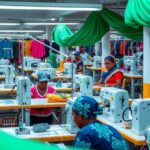Bangladesh Seeks US Talks Amid Risks to $40 Billion Export Sector
Bangladesh is seeking discussions with the US to address new 37% tariffs on its exports, particularly affecting its $40 billion garment industry. With garments making up 90% of exports to the US, the country faces significant economic risk. Potential strategies include increasing imports from the US, especially raw cotton, to reduce the trade deficit and maintain essential economic growth.
Bangladesh is initiating discussions with the Trump administration to mitigate the impact of a recent decision imposing a 37% tariff on its goods, particularly affecting the country’s $40 billion garment export industry. Officials assert that reducing the trade surplus with the US is essential to lessen the duties imposed on Bangladeshi exports. This tariff rate is one of the highest enforced on any nation, threatening significant economic disruption in Bangladesh, which relies heavily on textile exports.
Garment exports constitute nearly 90% of Bangladesh’s total sales to the US, making the stakes remarkably high for its economy. The country is still recovering from a previous political crisis and is dependent on foreign aid, notably from the International Monetary Fund (IMF). The newly established tariffs are formulated based on US bilateral trade deficits, which some analysts deem inherently unfair to nations like Bangladesh with substantial trade surpluses.
The government is consulting key stakeholders, including the Export Promotion Bureau, to strategize on addressing the tariffs. One potential solution involves augmenting imports of American goods, particularly raw cotton, to help narrow the trade deficit. Anwar Hossain, the administrator of the Bangladesh Garment Manufacturers and Exporters Association, mentioned the necessity of a reliable supply chain for American cotton to facilitate this increase.
Major US retailers, including Walmart and Gap, procure significant amounts of clothing from Bangladesh each year. The tariff increase could lead these retailers to reconsider their sourcing strategies, according to Hossain. Notably, Bangladesh’s exports to the US have seen a slight increase of 1.1%, reaching $8.4 billion in 2024, while US exports to Bangladesh have declined by 1.5%.
The tariffs may hinder Bangladesh’s ability to meet IMF bail-out program targets, as highlighted by economist Ankur Shukla. He warns that this situation may jeopardize loans from the fund and pose additional risks to economic growth. Conversely, Bangladeshi tariff rates are lower when compared to competitors like Sri Lanka and Vietnam, which could provide a potential comparative advantage.
Despite the challenges posed by the current tariff situation, officials believe there may be opportunities for adjustment through reciprocal trade negotiations. Sk. Bashir Uddin emphasized the global ramifications of the US trade decision, stating that this issue transcends bilateral concerns, indicating a comprehensive global economic impact.
The recent imposition of a 37% tariff by the US on Bangladeshi goods has raised serious concerns regarding the future of the country’s garment industry, which is crucial to its economy. As Bangladesh seeks to engage in dialogue with the US administration to minimize the economic fallout, analysts predict this could lead to significant adjustments in trade dynamics. While challenges persist, the potential for establishing a more favorable trade relationship remains.
Original Source: ww.fashionnetwork.com






Post Comment